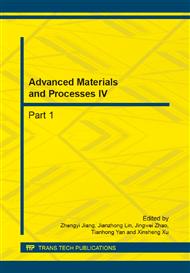[1]
A.S. Gorshkov: The energy efficiency in the field of construction: questions of norms and standarts and solutions for the reduction of energy consumption at buildings, Magazine of Civil Engineering, 1 (2010) рр. 9-13.
Google Scholar
[2]
N.I. Vatin, D.V. Nemova, D.S. Tarasova, A.A. Staritcyna: Increase of energy efficiency for educational institution building, Advanced Materials Research, 953-954 (2014) pp.854-870.
DOI: 10.4028/www.scientific.net/amr.953-954.854
Google Scholar
[3]
N.I. Vatin, D.V. Nemova: Increase of power efficiency of buildings of kindergartens, Construction of Unique Buildings and Structures, 3 (2012) pp.52-76.
Google Scholar
[4]
M.R. Petrichenko: Nonsteady filtration in a uniform soil mass, Power Technology and Engineering, (2012) pp.1-3.
Google Scholar
[5]
M.R. Petrichenko, V.N. Bukhartsev: Problem of filtration in a uniform rectangular soil mass is solved by variational principles, Power Technology and Engineering, 46 (3) (2012) pp.185-189.
DOI: 10.1007/s10749-012-0329-6
Google Scholar
[6]
V.N. Bukhartsev, M.R. Petrichenko: Approximation of the depression curve of the inflow to an ideal trench, Power Technology and Engineering, 44 (5) (2011) pp.374-377.
DOI: 10.1007/s10749-011-0193-9
Google Scholar
[7]
M.R. Petrichenko, N.S. Khar'kov: Experimental study of the pumping action of helical flow, Technical Physics, 54 (7) (2009) pp.1063-1065.
DOI: 10.1134/s1063784209070238
Google Scholar
[8]
M.R. Petrichenko: Convective heat and mass transfer in combustion chambers of piston engines. Basic results, Heat transfer. Soviet research, United States 23 (5) (1991) pp.703-715.
Google Scholar
[9]
R.M. Petrichenko, A.B. Kanishchev, L.A. Zakharov, B. Kandakzhi: Some principles of combustion of homogeneous fuel-air mixtures in the cylinder of an internal combustion engine Journal of Engineering Physics, 59 (6) (1990) pp.1539-1544.
DOI: 10.1007/bf00870411
Google Scholar
[10]
R.M. Petrichenko, A. Yu. Shabanov: Hydrodynamics of oil film under internal combustion engine piston rings, Trudy LPI, 411 (1985) pp.38-42.
Google Scholar
[11]
N.I. Vatin: Weight vector of a conduction transducer of a correlation flowmeter, Magnetohydrodynamics New York, N.Y., 21 (3) (1985) pp.316-320.
Google Scholar
[12]
A. Borodinecs, B. Gaujena: The implementation of building envelopes with controlled thermal resistance. 10th International Conference on Healthy Buildings (2012) pp.1715-1722.
Google Scholar
[13]
A. Kaklauskas, J. Rute. E. Zavadskas, A. Daniunas. V. Pruskus, J. Bivainis, R. Gudauskas, V. Plakys: Passive House model for quantitative and qualitative analyses and its intelligent system, Energy and Buildings, 50 (2012) pp.7-18.
DOI: 10.1016/j.enbuild.2012.03.008
Google Scholar
[14]
N.I. Vatin, D.V. Nemova, A.S. Kazimirova, K.N. Gureev: Increase of energy efficiency of the building of kindergarten, Advanced Materials Research, 953-954 (2014) pp.1537-1544.
DOI: 10.4028/www.scientific.net/amr.953-954.1537
Google Scholar
[15]
N.I. Vatin, A.S. Gorshkov, D.V. Nemova, A.A. Staritcyna, D.S. Tarasova: The energy-efficient heat insulation thickness for systems of hinged ventilated facades, Advanced Materials Research, 941-944 (2014) pp.905-920.
DOI: 10.4028/www.scientific.net/amr.941-944.905
Google Scholar
[16]
N. Vatin, V. Murgul, G. Radovic: Fast urban development of Cetinje – old royal capital of Montenegro, Applied Mechanics and Materials, 584-586 (2014) pp.564-569.
DOI: 10.4028/www.scientific.net/amm.584-586.564
Google Scholar
[17]
H. Kus, K. Nygren, P. Norberg: In-use performance assessment of rendered autoclaved aerated concrete walls by long-term moisture monitoring, Building and Environment, 39 (2004) pp.677-687.
DOI: 10.1016/j.buildenv.2003.12.006
Google Scholar
[18]
H. Radhi: Viability of autoclaved aerated concrete walls for the residential sector in the United Arab Emirates, Energy and Buildings, 43 (2011) p.2086-(2092).
DOI: 10.1016/j.enbuild.2011.04.018
Google Scholar
[19]
I. Kadashevich, D. Stoyan: A beam-network model for autoclaved aerated concrete and its use for the investigation of relationships between Young's modulus and microstructure, Computational Materials Science, 43 (2008) pp.293-300.
DOI: 10.1016/j.commatsci.2007.11.005
Google Scholar


